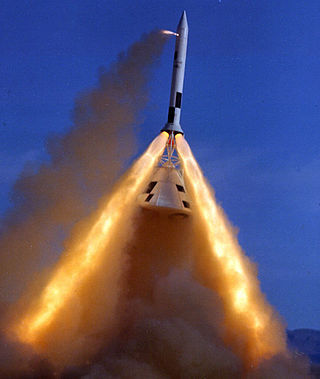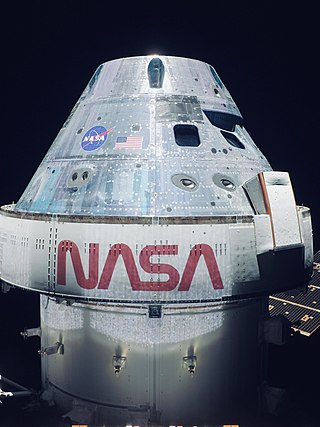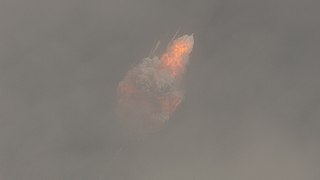
The Space Shuttle program was the fourth human spaceflight program carried out by the U.S. National Aeronautics and Space Administration (NASA), which accomplished routine transportation for Earth-to-orbit crew and cargo from 1981 to 2011. Its official name, Space Transportation System (STS), was taken from a 1969 plan for a system of reusable spacecraft of which it was the only item funded for development. It flew 135 missions and carried 355 astronauts from 16 countries, many on multiple trips.

The Constellation program was a crewed spaceflight program developed by NASA, the space agency of the United States, from 2005 to 2009. The major goals of the program were "completion of the International Space Station" and a "return to the Moon no later than 2020" with a crewed flight to the planet Mars as the ultimate goal. The program's logo reflected the three stages of the program: the Earth (ISS), the Moon, and finally Mars—while the Mars goal also found expression in the name given to the program's booster rockets: Ares. The technological aims of the program included the regaining of significant astronaut experience beyond low Earth orbit and the development of technologies necessary to enable sustained human presence on other planetary bodies.

A launch escape system (LES) or launch abort system (LAS) is a crew-safety system connected to a space capsule. It is used in the event of a critical emergency to quickly separate the capsule from its launch vehicle in case of an emergency requiring the abort of the launch, such as an impending explosion. The LES is typically controlled by a combination of automatic rocket failure detection, and a manual activation for the crew commander's use. The LES may be used while the launch vehicle is still on the launch pad, or during its ascent. Such systems are usually of three types:

The Exploration Systems Architecture Study (ESAS) is the official title of a large-scale, system level study released by the National Aeronautics and Space Administration (NASA) in November 2005 of his goal of returning astronauts to the Moon and eventually Mars—known as the Vision for Space Exploration. The Constellation Program was cancelled in 2010 by the Obama Administration and replaced with the Space Launch System, later renamed as the Artemis Program in 2017 under the Trump Administration.

The Minotaur is a family of United States solid fuel launch vehicles derived from converted Minuteman and Peacekeeper intercontinental ballistic missiles (ICBM). They are built by Northrop Grumman via contract with the Air Force Space and Missile Systems Center's Space Development and Test Directorate (SMC/SD) as part of the Air Force's Rocket Systems Launch Program which converts retired Intercontinental Ballistic Missiles into space and test launch systems for U.S. government agencies.

A boilerplate spacecraft, also known as a mass simulator, is a nonfunctional craft or payload that is used to test various configurations and basic size, load, and handling characteristics of rocket launch vehicles. It is far less expensive to build multiple, full-scale, non-functional boilerplate spacecraft than it is to develop the full system. In this way, boilerplate spacecraft allow components and aspects of cutting-edge aerospace projects to be tested while detailed contracts for the final project are being negotiated. These tests may be used to develop procedures for mating a spacecraft to its launch vehicle, emergency access and egress, maintenance support activities, and various transportation processes.

New Shepard is a fully reusable sub-orbital launch vehicle developed for space tourism by Blue Origin. The vehicle is named after Alan Shepard, who became the first American to travel into space and the fifth person to walk on the Moon. The vehicle is capable of vertical takeoff and landings. Additionally, it is also capable of carrying humans and customer payloads into a sub-orbital trajectory.

The Orion Multi-Purpose Crew Vehicle is equipped with a launch escape system. Orion has several abort modes. Some of these may not use the LAS itself, but would use the second stage of the SLS, or even the Orion vehicle's own propulsion system instead.

Ares I-X was the first-stage prototype and design concept demonstrator of Ares I, a launch system for human spaceflight developed by the National Aeronautics and Space Administration (NASA). Ares I-X was successfully launched on October 28, 2009. The project cost was $445 million.
A pad abort test is a kind of test of a launch escape system which conducted by setting the system along with the spacecraft still on the ground and let the system activate to carry the spacecraft flying away, then separate in the air and make the spacecraft land safely. The purpose of the test is to determine how well the system could get the crew of a spacecraft to safety in an emergency on the launch pad. As the spacecraft is set still on the ground, the test is also called "zero-altitude abort test" in against "high-altitude abort test".

The Space Launch System (SLS) is an American super heavy-lift expendable launch vehicle used by NASA. As the primary launch vehicle of the Artemis Moon landing program, SLS is designed to launch the crewed Orion spacecraft on a trans-lunar trajectory. The first SLS launch was the uncrewed Artemis 1, which took place on 16 November 2022.

Orion is a partially reusable crewed spacecraft used in NASA's Artemis program. The spacecraft consists of a Crew Module (CM) space capsule designed by Lockheed Martin and the European Service Module (ESM) manufactured by Airbus Defence and Space. Capable of supporting a crew of four beyond low Earth orbit, Orion can last up to 21 days undocked and up to six months docked. It is equipped with solar panels, an automated docking system, and glass cockpit interfaces modeled after those used in the Boeing 787 Dreamliner. A single AJ10 engine provides the spacecraft's primary propulsion, while eight R-4D-11 engines, and six pods of custom reaction control system engines developed by Airbus, provide the spacecraft's secondary propulsion. Orion is intended to launch atop a Space Launch System (SLS) rocket, with a tower launch escape system.

Exploration Flight Test-1 or EFT-1 was the first test flight of the crew module portion of the Orion Multi-Purpose Crew Vehicle. Without a crew, it was launched on December 5, 2014, at 12:05 UTC, by a Delta IV Heavy rocket from Space Launch Complex 37B at Cape Canaveral Space Force Station.

Artemis 1, officially Artemis I and formerly Exploration Mission-1 (EM-1), was an uncrewed Moon-orbiting mission. As the first major spaceflight of NASA's Artemis program, Artemis 1 marked the agency's return to lunar exploration after the conclusion of the Apollo program five decades earlier. It was the first integrated flight test of the Orion spacecraft and Space Launch System (SLS) rocket, and its main objective was to test the Orion spacecraft, especially its heat shield, in preparation for subsequent Artemis missions. These missions seek to reestablish a human presence on the Moon and demonstrate technologies and business approaches needed for future scientific studies, including exploration of Mars.

The European Service Module (ESM) is the service module component of the Orion spacecraft, serving as its primary power and propulsion component until it is discarded at the end of each mission. In January 2013, NASA announced that the European Space Agency (ESA) will contribute the service module for Artemis 1, based on the ESA's Automated Transfer Vehicle (ATV). It was delivered by Airbus Defence and Space in Bremen, in northern Germany to NASA at the end of 2018. After approval of the first module, the ESA will provide the ESMs from Artemis 2 to Artemis 6.

Soyuz MS-10 was a crewed Soyuz MS spaceflight that aborted shortly after launch on 11 October 2018 due to a failure of the Soyuz-FG launch vehicle boosters. MS-10 was the 139th flight of a Soyuz spacecraft. It was intended to transport two members of the Expedition 57 crew to the International Space Station. A few minutes after liftoff, the craft went into contingency abort due to a booster failure and had to return to Earth. By the time the contingency abort was declared, the launch escape system (LES) tower had already been ejected and the capsule was pulled away from the rocket using the solid rocket jettison motors on the capsule fairing. Both crew members, Roscosmos cosmonaut Aleksey Ovchinin and NASA astronaut Nick Hague, were recovered in good health. The MS-10 flight abort was the first instance of a Russian crewed booster accident in 35 years, since Soyuz T-10-1 exploded on the launch pad in September 1983. On 1 November 2018, Russian scientists released a video recording of the mission.

The Artemis program is a robotic and human Moon exploration program led by the United States' National Aeronautics and Space Administration (NASA) along with six major partner agencies— the European Space Agency (ESA), the German Aerospace Center (DLR), the Japan Aerospace Exploration Agency (JAXA), the Canadian Space Agency (CSA), the Israel Space Agency (ISA), and the Italian Space Agency (ASI). The Artemis program is intended to reestablish a human presence on the Moon for the first time since the Apollo 17 mission in 1972. The main parts of the program are the Space Launch System (SLS), the Orion spacecraft, the Lunar Gateway space station, and the commercial Human Landing Systems. The program's long-term goal is to establish a permanent base on the Moon to facilitate the feasibility of human missions to Mars.
Zond program was a Soviet robotic spacecraft program launched between 1964 and 1970, using two spacecraft series, one for interplanetary exploration, and the other for lunar exploration.

SpaceXCrew Dragon In-Flight Abort Test was a successful test of the SpaceX Dragon 2 abort system, conducted on 19 January 2020. It was the final assessment for the Crew Dragon capsule and Falcon 9 launch system before they would be certified to carry humans into space. Booster B1046.4 and an uncrewed capsule C205 were launched from Launch Complex 39A (LC-39A) on a suborbital trajectory, followed by an in-flight abort of the capsule at max Q and supersonic speed. The test was carried out successfully: the capsule pulled itself away from the booster after launch control commanded main engine shutdown and landed safely.

The Crew Dragon Pad Abort Test was a spacecraft test conducted by SpaceX on 6 May 2015 from the Space Launch Complex 40 (SLC-40) at Cape Canaveral Air Force Station, Florida. As part of the development of NASA's Commercial Crew Program, the test demonstrated the spacecraft's abort system capability, verifying the capsule's eight side-mounted SuperDraco thrusters' capability to quickly power itself away from a failing rocket while it is still on the ground. It was one of the two tests conducted by SpaceX on the abort system of spacecraft, the other one being the Crew Dragon In-Flight Abort Test conducted on 19 January 2020.




















